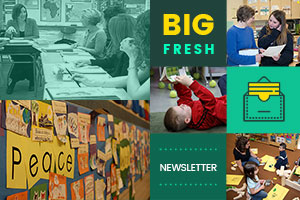Never underestimate the power of a tweet.
Germany Kent
To say I am a little addicted to Twitter is an understatement. I might even have three Twitter accounts. Yep, I might have an education Twitter account, a school account, and a public education advocacy account (#twitteraddict). I count on Twitter to help me stay informed about current events, connect with other educators, and keep my “to be read” book stack piled high. Twitter keeps me connected to educators, authors, and literacy leaders. I know I can always count on my Twitter connections to share smart thinking, interesting blog posts, and links to all the latest and greatest. Twitter is my go-to brain push.
When I start to discuss news with my husband, I’m the one who will often say, “I saw on Twitter ___” (fill in the blank with important news flash, smart new idea, sappy sarcasm, or a tidbit of gossip). When I meet people, one of the first things I wonder is if they have a Twitter account and if I should be following it. My kids will tell you the worst thing is the way I hashtag my text messages to them (#uncoolmom). Who can resist a good hashtag?
Oh, the hashtag. IMHO (in my humble opinion, couldn’t help myself), hashtags are one of the best parts about Twitter. They’re also one of the challenging obstacles in learning how to effectively navigate this social media platform. As if getting our thinking into 140 characters isn’t challenging enough, figuring out how to leverage the hashtag takes everything to a new level. Hashtags allow us to follow conversations without necessarily following the people in them. Hashtags can help us find important topics, follow threaded conversations, or make subtle statements about our tweets. As an educator I follow #nerdybookclub, #tcrwp, #FPliteracy, #1stchat, #cyberPD, and #weneeddiversebooks, to name a few.
This year I learned that hashtags can also help us stay open to new learning. Change seems to be a constant in our work. Change was amplified for me after accepting a new position this year. In education, changing grade levels, switching buildings, or moving to a new position can take the learning up a notch. But, new role or not, there’s always something to rethink or relearn. My new role is really a dream opportunity with time in classrooms alongside students, beside teachers, with coaches, and across 14 of our elementary schools. In addition to the opportunity to learn from so many people, I have new responsibilities in curriculum and policy that still make me uneasy. Let’s just say I’ve spent a lot of time reading and asking questions.
The struggle has been real. When it comes to policy, I started to feel like I was always asking questions. By the time March rolled around, I’d asked so many questions that I decided to create a hashtag for the closing of my emails that read #YepStillNew. It got quite a laugh and helped me feel a little better about my continual barrage of questions for colleagues, some of which I’m pretty sure I asked again and again.
Now I am in year two and there is still more learning ahead. I can’t use the #YepStillNew hashtag but, no worries, I’ve already coined a new hashtag that gives me a little space to keep growing. I’m thinking #StillLearning will be the perfect hashtag to keep the door open to all that is ahead.
What about you? What’s your hashtag? What are the words that keep you open to new learning?
Before there were hashtags to neatly sum up our thoughts, there were summaries and conclusions. That’s our theme this week. Plus more as always — enjoy!
Cathy Mere
Contributor, Choice Literacy
Cathy Mere is currently a literacy specialist in Hilliard (Ohio) City Schools. She is the author of More Than Guided Reading. A trained literacy coach and former Reading Recovery teacher, Cathy leads professional development workshops and presents at state and national conferences. She blogs at Refine and Reflect.
Free for All
[For sneak peeks at our upcoming features, quotes and extra links, follow Choice Literacy on Twitter: @ChoiceLiteracy or Facebook: http://www.facebook.com/ChoiceLiteracy or Pinterest: http://pinterest.com/choiceliteracy/]
One goal of many primary teachers is to help students finish their drafts with an ending other than “The End” (or “they lived happily ever after”). Katie DiCesare shows her first graders many alternative examples:
http://www.choiceliteracy.com/articles-detail-view.php?id=1853
Heather Rader coaches a sixth-grade teacher as she helps her students write better summaries:
http://www.choiceliteracy.com/articles-detail-view.php?id=737
Pernille Ripp energizes her students by having them write 12-word book summaries and then perform their work:
What’s your favorite closing line in a book? The Stylist blog compiled their 100 favorites. We suspect you’ll recognize many on the list:
http://www.stylist.co.uk/books/the-best-100-closing-lines-from-books#
For Members Only
Katherine Sokolowski finds her fifth graders can give detailed retellings during conferences, but struggle to come up with succinct summaries. Writing book blurbs is her creative solution for building summarizing skills:
http://www.choiceliteracy.com/articles-detail-view.php?id=2549
Anadiplosis, tricolon, syntax and such — when Gretchen Schroeder’s high school students are stuck in rhetorical ruts, she teaches them some new rhetorical tricks for crafting conclusions:
http://www.choiceliteracy.com/articles-detail-view.php?id=2835
In this week’s video, Christy Rush-Levine helps eighth grader Katherine sort through tools and strategies for writing a strong conclusion to her literary analysis essay:
http://www.choiceliteracy.com/articles-detail-view.php?id=2445
Are you a quote collector? Stephanie Affinito shares her love of quotes with students and also enlists them as quote collectors:
http://www.choiceliteracy.com/articles-detail-view.php?id=2887
In an encore video, Cathy Laker uses her own writing as a mentor text with her second-grade students to demonstrate options for endings:
http://www.choiceliteracy.com/articles-detail-view.php?id=1650
That’s all for this week!



